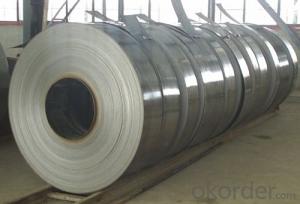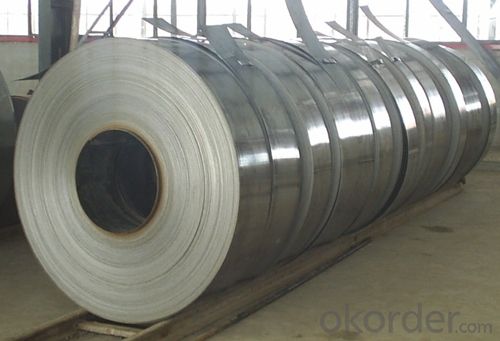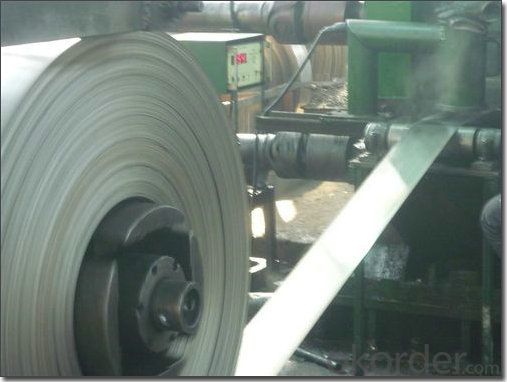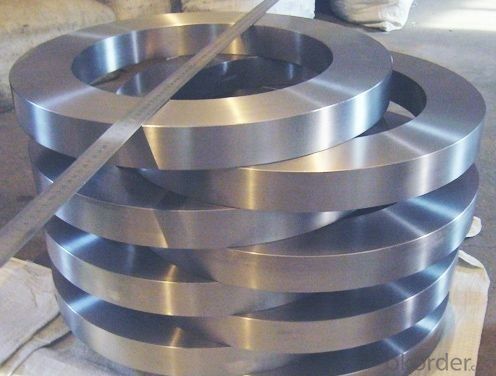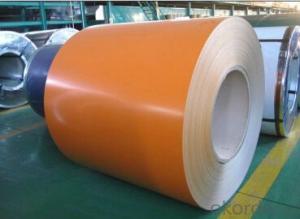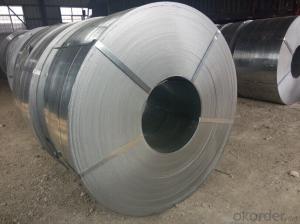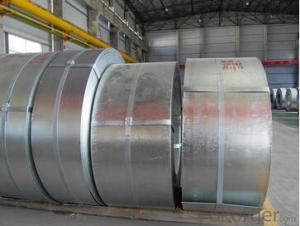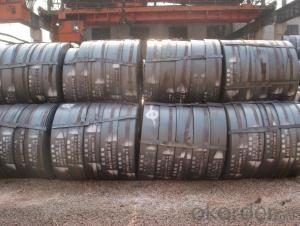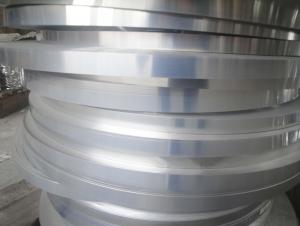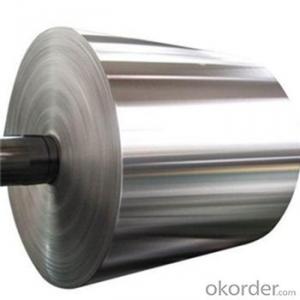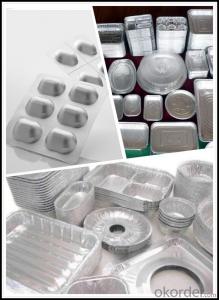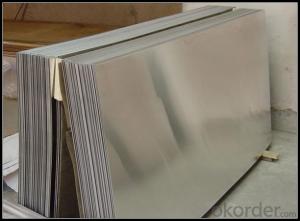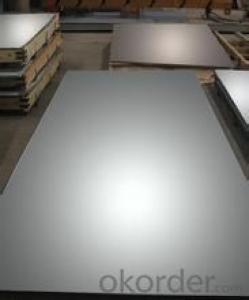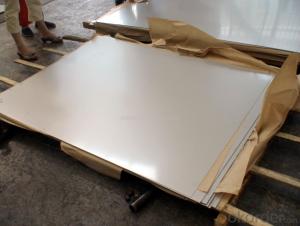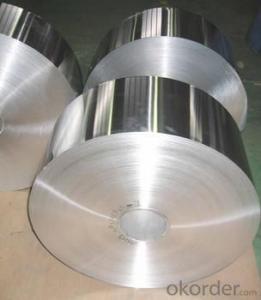Cold Rolled Steel Strip
- Loading Port:
- China Main Port
- Payment Terms:
- TT OR LC
- Min Order Qty:
- -
- Supply Capability:
- -
OKorder Service Pledge
OKorder Financial Service
You Might Also Like
Cold rolled stirps
Specification
Products: | |||
Item | Specification (mm) | ||
Diameter | Thickness | Length | |
Cold roll steel strip | 0.15mm-2.0mm | SIZE | |
Black CR steel strip | WIDTH:1000-2000mm Length:2000-6000mm | ||
Bright CR steel strip | |||
Detail information: | |||
Material | Q195,Q195L.Q235,SPCC,etc | ||
Standard | bright/dull/black finishe | ||
Thickness Tolerance | <>0.02 0.04 | ||
Certificate | SGS Certificate of meeded;the cost of inspection for buyer | ||
MOQ | 20T | ||
| Widely used in electronic production,Motorbike,Automobile,Stamping structure;Cold bent Sreel;Saw flake and etc;which is a good substitute for cold Roller and Cold plate in many field. | ||
Usage | |||
Production capacity | 15,000MT per month | ||
Packing | export standard packing | ||
delivery time | within 30 days after receipt of the advance payment or L/C | ||
delivery port | Tianjin xin'gang,china | ||
Main Market | Europe,America.Australia,Southeast | ||
Welcome every old and new customers to come to negotiate and telecommunicate with us. | |||
- Q: What are the specifications for steel strips used in the aerospace industry?
- To guarantee the utmost safety and performance, the aerospace industry imposes stringent and meticulous specifications on steel strips. Here are some of the vital requirements: 1. Composition of Materials: Chemical compositions of the steel strips must adhere to specific standards to meet the desired strength, durability, and resistance to corrosion. Stainless steel, high-strength low-alloy (HSLA) steel, and nickel-based alloys are commonly utilized. 2. Tolerances for Dimensions: The steel strips must conform to precise dimensional tolerances to ensure suitable fit and functionality within aerospace components. This encompasses measurements of thickness, width, and length, often indicated in micrometers or inches. 3. Surface Finish: The surface finish of the steel strips plays a crucial role in minimizing friction, preventing corrosion, and optimizing performance. It is often expressed in terms of roughness average (RA) or surface finish grade. Additionally, additional coatings or treatments may be necessary to enhance surface properties. 4. Mechanical Properties: The steel strips employed in aerospace applications must possess specific mechanical properties, including tensile strength, yield strength, elongation, and hardness. These properties guarantee that the strips can withstand the challenging conditions encountered during flight, such as high temperatures, vibrations, and external forces. 5. Heat Treatment: Depending on the intended use, the steel strips may require specific heat treatment processes to enhance their mechanical properties. This may involve techniques such as annealing, quenching, tempering, or precipitation hardening, with the aim of achieving the desired strength, toughness, or ductility. 6. Certification and Testing: Steel strips used in the aerospace industry undergo rigorous testing and certification procedures to ensure compliance with industry standards and regulations. Non-destructive testing methods, such as ultrasonic testing, magnetic particle testing, or dye penetrant inspection, are employed to identify any defects or flaws. It is important to note that the precise specifications for steel strips utilized in the aerospace sector may vary depending on specific applications, aircraft types, and regulatory requirements. Therefore, it is crucial to consult the relevant aerospace standards and specifications for precise details.
- Q: How do steel strips behave under different loading conditions?
- Steel strips behave differently under different loading conditions. When subjected to tensile loading, the steel strips elongate and stretch due to the applied force. This is the result of the internal atomic structure of steel, which allows it to deform plastically under tension. However, if the applied load exceeds the ultimate strength of the steel, it will experience necking and eventually fracture. Under compressive loading, steel strips tend to buckle or crumple. This occurs when the compressive force causes the steel to lose its stability and deform in a non-linear manner. The behavior of the steel strip under compression depends on various factors such as its geometry, aspect ratio, and boundary conditions. In bending, steel strips experience both tensile and compressive stresses. The top surface of the strip undergoes tensile stress, while the bottom surface experiences compressive stress. This creates a neutral axis in the middle, where there is no stress. The behavior of steel strips under bending depends on their cross-sectional shape, thickness, and the applied moment. When subjected to torsional loading, steel strips twist along their length. This occurs due to the shear stress induced by the applied torque. The behavior of steel strips under torsion depends on their cross-sectional shape and material properties. In summary, steel strips exhibit different behaviors under different loading conditions. Understanding these behaviors is crucial for designing and engineering structures that utilize steel strips effectively.
- Q: What are the different heat treatment methods for steel strips?
- Steel strips can undergo various heat treatment methods, each serving its own purpose and offering unique advantages. These methods encompass annealing, quenching and tempering, hardening, and case hardening. 1. Annealing: In annealing, the steel strip is heated to a specific temperature and subsequently cooled slowly. This process alleviates internal stresses, enhances the steel's machinability, and improves ductility. Additionally, it refines the grain structure, resulting in a material that is softer and more homogeneous. 2. Quenching and tempering: Quenching involves rapidly cooling the steel strip by immersing it in a medium such as water or oil to achieve high hardness and strength. After quenching, the steel strip is tempered by reheating it to a lower temperature, reducing brittleness and improving toughness. This method is commonly employed to manufacture high-strength steel strips for applications requiring resistance to wear and impact. 3. Hardening: Hardening entails heating the steel strip to a specific temperature and then rapidly cooling it to achieve high hardness and strength. Unlike quenching and tempering, hardening does not involve the tempering process, thus maintaining the steel strip's hardness and strength. This method is suitable for applications demanding maximum hardness, such as cutting tools and machine parts. 4. Case hardening: Case hardening is a surface hardening process that involves introducing carbon to the surface of the steel strip. This increases its hardness while retaining a relatively soft and tough core. Achieved by heating the steel strip in a carbon-rich environment, case hardening provides exceptional wear resistance and is commonly used for gears, shafts, and other durable components. Ultimately, the choice of heat treatment method for steel strips is contingent upon the desired properties and specific application requirements. These diverse methods offer varying combinations of hardness, strength, toughness, and wear resistance, enabling manufacturers to customize steel strips to meet their unique needs.
- Q: Are steel strips used in the production of automotive body panels?
- Yes, steel strips are commonly used in the production of automotive body panels. Steel is a widely used material in the automotive industry due to its strength, durability, and cost-effectiveness. Steel strips are typically used to form the basic structure of the body panels, such as the roof, doors, fenders, and hood. These strips are often shaped and welded together to create the desired panel shape. Additionally, steel strips provide excellent protection against impact and help maintain the structural integrity of the vehicle. However, with advancements in technology, other materials like aluminum and carbon fiber are also being used in the production of automotive body panels due to their lighter weight and improved fuel efficiency.
- Q: What are the common tolerances for steel strips?
- The common tolerances for steel strips vary depending on the specific application and industry standards. However, some commonly accepted tolerances for steel strips include thickness tolerances ranging from +/- 0.001 inches to +/- 0.010 inches, width tolerances ranging from +/- 0.005 inches to +/- 0.020 inches, and length tolerances ranging from +/- 0.010 inches to +/- 0.050 inches. These tolerances ensure that the steel strips meet the required specifications and can be used effectively in various manufacturing processes.
- Q: Can steel strips be used in the production of kitchen appliances?
- Yes, steel strips can be used in the production of kitchen appliances. Steel is a common material used in the manufacturing of kitchen appliances due to its durability, strength, and resistance to heat and corrosion. Steel strips can be formed into various components and parts such as panels, frames, and shelves, making them suitable for use in kitchen appliances like ovens, refrigerators, and dishwashers.
- Q: How are steel strips polished?
- Steel strips are polished using a process called mechanical polishing, where abrasive materials such as sandpaper or polishing wheels are used to remove imperfections and create a smooth and shiny surface on the steel strips.
- Q: How are steel strips used in the construction of buildings?
- Steel strips are commonly used in the construction of buildings for various purposes such as reinforcing concrete structures, providing stability and strength, and creating frames for doors, windows, and partitions. They are also used in the installation of electrical and plumbing systems, providing support and durability to the overall structure.
- Q: How are steel strips measured for dimensional accuracy?
- To ensure dimensional accuracy, steel strips undergo measurement using a range of techniques and instruments. One commonly employed method involves the use of a digital caliper, a precision measuring tool featuring an adjustable jaw that fits the strip's width. With its digital readout, the caliper enables precise measurements. Another technique involves the utilization of a micrometer, a specialized measuring tool renowned for its high accuracy. A micrometer comprises a calibrated screw mechanism that is tightened around the strip, along with a scale or digital display for measurement readout. Apart from handheld instruments, automated measuring systems are available for measuring steel strips. These systems employ lasers or vision-based technology to swiftly and accurately assess the strip's dimensions. They find extensive application in industrial settings that require the measurement of large volumes of steel strips. Irrespective of the chosen method, it is crucial to ensure proper calibration of the measuring instrument. Additionally, measurements should be taken at multiple points along the strip to account for possible variations in width. This practice guarantees the maintenance of dimensional accuracy, which is vital for ensuring the steel strip's proper fit and performance across diverse applications.
- Q: How do steel strips contribute to product longevity in various applications?
- There are several ways in which steel strips contribute to the longevity of products in various applications. To begin with, steel strips possess remarkable durability and resistance to wear and tear. They can endure heavy loads, impacts, and harsh environmental conditions without easily becoming deformed or damaged. This strength and durability guarantee that products created with steel strips have a longer lifespan compared to those made with alternative materials. Furthermore, steel strips exhibit outstanding resistance to corrosion. They are frequently coated with protective layers, such as zinc or chromium, in order to prevent rusting and corrosion. This protective coating acts as a barrier, shielding the underlying steel from moisture, chemicals, and other corrosive elements. Consequently, products constructed with steel strips are less prone to corroding and deteriorating over time, ensuring their longevity. Moreover, steel strips offer a high strength-to-weight ratio, meaning they provide considerable strength while being relatively lightweight. This characteristic is particularly advantageous in applications where weight is a concern, such as in the automotive or aerospace industries. The utilization of steel strips allows for the production of lighter products without compromising their structural integrity and durability. Additionally, steel strips can be easily shaped and fabricated into various forms and sizes, making them highly versatile. This versatility enables manufacturers to create products tailored to specific applications, guaranteeing optimal performance and longevity. Furthermore, steel strips can be efficiently joined or welded together, enabling the construction of complex structures that are robust and long-lasting. Lastly, steel strips are recyclable. At the end of their lifespan, steel strips can be recycled and repurposed to manufacture new products. This recyclability not only reduces the environmental impact of steel production but also contributes to the sustainability of products made with steel strips. In conclusion, steel strips contribute to the longevity of products in various applications through their durability, corrosion resistance, high strength-to-weight ratio, versatility in shaping and fabrication, and recyclability. These characteristics ensure that products created with steel strips can withstand the test of time and continue to perform reliably for extended periods.
Send your message to us
Cold Rolled Steel Strip
- Loading Port:
- China Main Port
- Payment Terms:
- TT OR LC
- Min Order Qty:
- -
- Supply Capability:
- -
OKorder Service Pledge
OKorder Financial Service
Similar products
Hot products
Hot Searches
Related keywords
